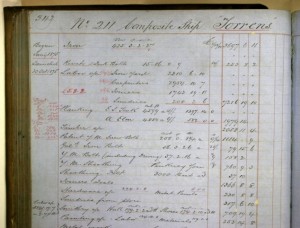It’s been an exciting past month on the Sunderland Shipbuilding archives project. For one thing I now have a ‘glamorous’ assistant, Colin Boyd, who will be working part-time with me for the next year. Colin has worked in the shipbuilding industry and so he brings valuable technical and historical knowledge to the project. He is already making excellent progress sorting through the large quantity of unlisted ships plans we hold for the company of Bartram and Sons Ltd.
Most of my recent work has focussed on cataloguing the records of the firm of Sir James Laing & Sons Ltd. The firm dates back to 1793 and was established by two brothers, Philip and James Laing, who moved to Sunderland from Fife, in Scotland. Our collection of Laings records is one of the largest that I will work on during the project and includes many of the oldest Sunderland shipbuilding documents we hold.
The earliest shipbuilding record we hold for Sunderland is a ships particulars book for Laings dating from 1794 to 1895 (TWAM ref. DS.LG/4/2/1). This is a fascinating volume, which includes general information about the earliest vessels built by the firm. The collection is full of such gems and includes something to appeal to everyone. For instance there’s a wage book covering the years 1800-1801 (TWAM ref. DS.LG/2/12/1). This wage book is by far the oldest shipbuilding employee record we hold for Sunderland. The names in the book will be of interest to family historians, while the information about rates of pay to foremen, carpenters, hewers, sawyers, borers and smiths should prove just as valuable for social history research.
I also recently discovered an early ships cost book for Laings (TWAM ref. DS.LG/4/12/1). This cost book contains interesting details of the materials and labour used in building individual ships and includes the names of firms that supplied Laings. This cost book dates back to 1857 and includes a double-page entry for one of the best known vessels built on the River Wear, the ‘Torrens’.
Launched in 1875, she was a composite ship of iron frame and wooden planks. The ‘Torrens’ was renowned for her speed and set a new record journey time from London to Adelaide, making the voyage in 64 days. She is also well known through her association with the novelist, Joseph Conrad, who served as an officer on the ‘Torrens’ in the early 1890s, during which time he started writing his first novel.
The collection includes many excellent series of photographs. These relate mainly to the ships built by Laings and I hope to include some of these images in a future blog, once they have been catalogued. Other subjects are covered as well, including royal visits, employees and the shipyard premises. I’m particularly keen on aerial photographs and the collection includes several excellent shots of the Deptford Yard, taken in July 1959 by the firm Turners (Photography) Ltd. As well as showing the shipyard itself they also reveal fascinating details of the surrounding area.
All in all, it’s been a busy but very rewarding month … and that’s without mentioning a fantastic new donation of Sunderland shipbuilding records that I collected just over a week ago. I’d love to reveal more but that will have to wait till next month’s blog.



6 Responses to Recent developments on the ‘We Mak’em’ Sunderland Shipbuilding archives project